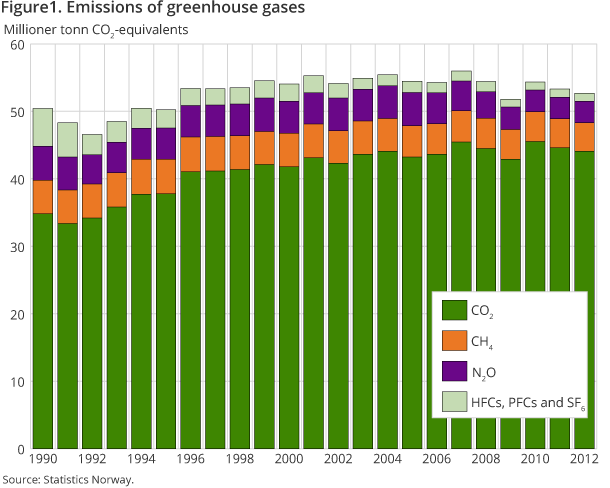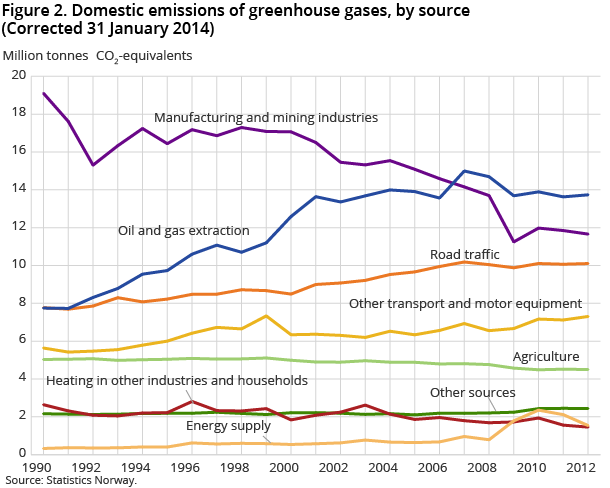Content
Published:
This is an archived release.
Reduction in greenhouse gas emissions in 2012
In 2012, the Norwegian domestic greenhouse gas emissions equalled 52.7 million tonnes of CO 2 equivalents. This represents a decrease of 1.1 per cent from the previous year. Reduced emissions from gas power plants have contributed to the decrease.
| 2012 | Change in per cent | ||
|---|---|---|---|
| Since 1990 | 2011 - 2012 | ||
| 1Figure for the previous year. Source: The Norwegian Forest and Landscape Institute. | |||
| Emissions from Norwegian territory | 52.7 | 4.6 | -1.1 |
| Oil and gas extraction | 13.7 | 77.3 | 0.8 |
| Manufacturing industries and mining | 11.7 | -39.0 | -1.6 |
| Energy supply | 1.5 | 373.2 | -27.2 |
| Heating in other industries and households | 1.5 | -44.8 | -6.7 |
| Road traffic | 10.1 | 30.0 | 0.4 |
| Aviation, navigation, fishing, motor equip. etc. | 7.3 | 29.6 | 2.6 |
| Agriculture | 4.5 | -10.6 | -0.4 |
| Other | 2.4 | 12.9 | -0.3 |
| Sinks and emissions from forest and land areas in Norway1 | -27.6 | 79.7 | .. |
| Emissions from international air and ocean transport | 11.2 | -21.1 | 1.2 |
| International air transport - Norwegian airlines | 2.1 | 238.6 | 16.2 |
| International ocean transport - Norwegian operated ships | 9.1 | -32.8 | -1.7 |


These findings are taken from the revised figures for greenhouse gas emissions 1980-2012. The new figures confirm the trend in the preliminary figures published in May 2013. Greenhouse gas emissions were 4.6 per cent higher in 2012 than in 1990. Nevertheless, the greenhouse gas emissions in 2012 were the lowest since 1995, with the exception of 2009, when reduced economic activity caused considerably lower emissions, compared with the preceding and following years.
Both CO 2 and other greenhouse gas emissions decreased in recent years
From 2010 to 2012, CO 2 emissions decreased by 3.2 per cent and in 2012 CO 2 amounted to 84 per cent of total greenhouse gas emissions. In 1990, the corresponding share was 69 per cent. Between 1990 and 2012, the CO 2 emissions increased from 34.8 to 44.1 million tones; an increase of nearly 27 per cent. An increase in emissions from oil and gas extraction was the main cause of higher CO 2 emissions in 2012 than in 1990.
Unlike CO 2 emissions, emissions of methane, nitrous oxide and fluorinated gases have declined since 1990, with an overall decrease of 44.6 per cent. Since 2010, the decline has been 2.0 per cent.
The main sources of methane are agriculture, landfills, and oil and gas extraction. The decline has been almost 15 per cent between the years 1990 and 2012.
Emissions of nitrous oxide were reduced by 37 per cent in the period 1990 to 2012, but have been stable for the last three years. In 2012, agriculture was the main source of these emissions and accounted for about 72 per cent of the total.
Emissions of fluorinated gases were 2.6 per cent lower in 2012 than the previous year, and 78 per cent lower than in 1990. The closure of magnesium production and technology improvements in aluminium production were the main reasons for the reduction.
Oil and gas extraction is the main source of greenhouse gas emissions
Emissions from oil and gas, manufacturing and road traffic accounted for around two thirds of greenhouse gas emissions in both 1990 and 2012. The relationship between these has, however, changed considerably during the period. In 1990, emissions from industry were larger than the oil and gas industry and road transport, but since 2007, the oil and gas industry has been the main source. In 2012, this source accounted for 26 per cent of emissions, compared with 15 per cent in 1990. Since 2009, the size of these emissions has been relatively stable.
Manufacturing is the second largest source of emissions, but continues to decrease
Manufacturing accounted for 22 per cent of emissions in 2012. This was much lower than the corresponding share of almost 38 per cent in 1990. The total amount of greenhouse gas emissions from industry declined by about 40 per cent between 1990 and 2012. The main reasons for the decline are business closures, improvements in technology and less use of oil products. In 2012, the decline was particularly large in the wood processing industry due to business closures.
Road traffic accounted for 19 percent of emissions
Road traffic was the third most important source of greenhouse gas emissions in 2012. Emissions from this source increased by 0.4 per cent from the previous year and amounted to 10.1 million tonnes of CO 2 - equivalents. Since 1990, emissions from road traffic have increased by 30 per cent. Growth has been weaker in recent years, which in particular can be explained by more energy-efficient vehicles and the transition from gasoline to diesel, which also results in lower emissions of greenhouse gases per kilometre.
Slightly lower emissions from agriculture
Emissions from agriculture have been relatively stable from year to year. These emissions have decreased by 11 per cent since 1990, primarily due to fewer cattle and reduced use of fertilizers. Emissions from agriculture accounted for 8.5 per cent of greenhouse gas emissions in 2012.
Low electricity prices contributed to lower emissions from energy supply and heating
Emissions from energy supply accounted for about 3 per cent of emissions in 2012. Emissions were reduced by nearly 600 000 tonnes (27 per cent) compared to the previous year, mainly as a result of very low activity in gas-fired power plants. The reason for this was low electricity prices that made the production of energy from power plants unprofitable.
Low electricity prices also contributed to the decrease in heating sector emissions, and these emissions totalled 1.5 million tonnes of CO 2 equivalents in 2012. Emissions from the heating sector have been reduced by 45 per cent since 1990.
Considerable net sinks in forest
Since the 1920s, the cutting of Norwegian forests has been lower than the growth. This means that Norway has larger sinks than emissions of CO 2 in forests. According to newly revised calculations by the Norwegian Forest and Landscape Institute, net sinks of greenhouse gases from forests and wooded areas in Norway amounted to approximately 28 million tonnes of CO 2 in 2011. This is about 53 per cent of recent years’ annual greenhouse gas emissions in CO 2 equivalents.
11 million tonnes of CO 2 equivalents from international aviation and maritime transport
Emissions from international shipping are estimated at about 9.1 million tonnes of CO 2 equivalents in 2012. International shipping includes Norwegian-driven ships and ships operated by Norwegian-registered shipping companies, regardless of vessel ownership or flag. Figures for emissions from shipping are calculated based on the cost of buying bunkers, and must be regarded as uncertain. International aviation or Norwegian airlines traffic abroad and to/from Norway, accounted for about 2.1 million tonnes of CO 2 equivalents in 2012. This emission source has grown rapidly in recent years. Emissions from this source have increased by about 16 per cent since 2011.
International obligations for Norway Open and readClose
Norway’s allocated emission quota from the UN amounts to 50.1 million tonnes of CO2 equivalents annually in the period 2008-2012. This is 1 per cent more than the domestic emissions in 1990. The emissions in 2008-2012 exceed the allocated annual amount. Norway can, however, fulfil the obligation by using three flexibility mechanisms: Joint Implementation, the Clean Development Mechanism and quota trading.
The emission inventory that annually is reported to the UN also includes emissions and sinks in forest and other land areas. According to the Kyoto Protocol, Norway is entitled annually to be credited approximately 1.5 million tonnes from sinks in forests for the years 2008-2012. Norway’s policy, however, is that these sinks shall not be used to fulfil the Kyoto Protocol obligations.
National targets on emission cutsOpen and readClose
In 2008, the majority in the Norwegian parliament entered into an agreement on a national target for emission reductions. The target is that domestic emissions shall not exceed 45-47 million tonnes of CO2 equivalents in 2020. In a Report to the Storting in 2012, this target was confirmed. In 2012, the emissions were 6-8 million tonnes above this national target.
Contact
-
Trude Melby Bothner
E-mail: trude.melby.bothner@ssb.no
tel.: (+47) 40 81 14 25
-
Berit Storbråten
E-mail: berit.storbraten@ssb.no
tel.: (+47) 40 81 14 23
